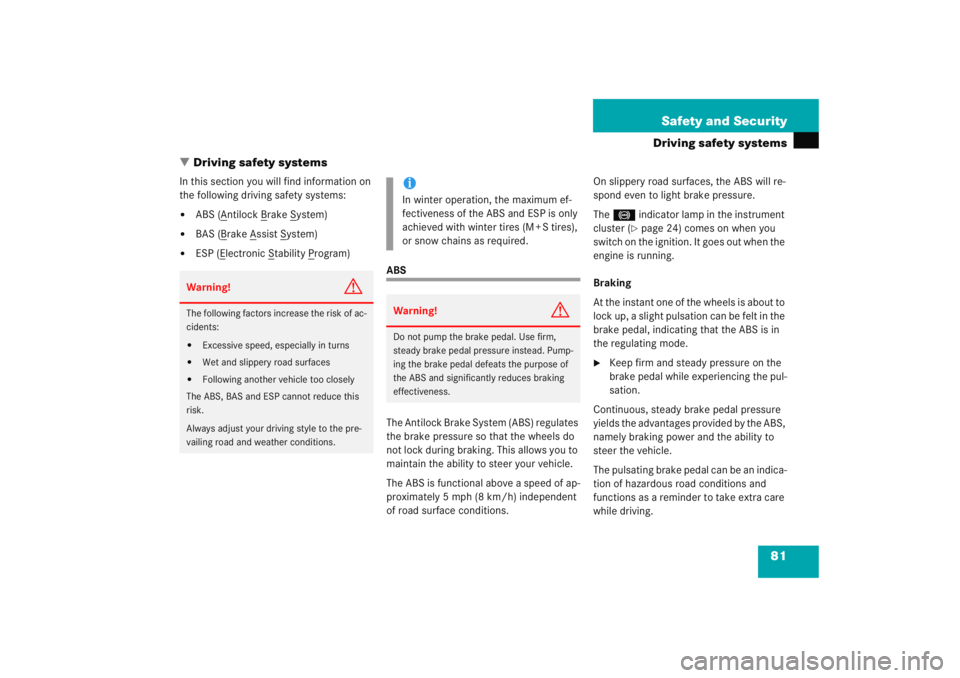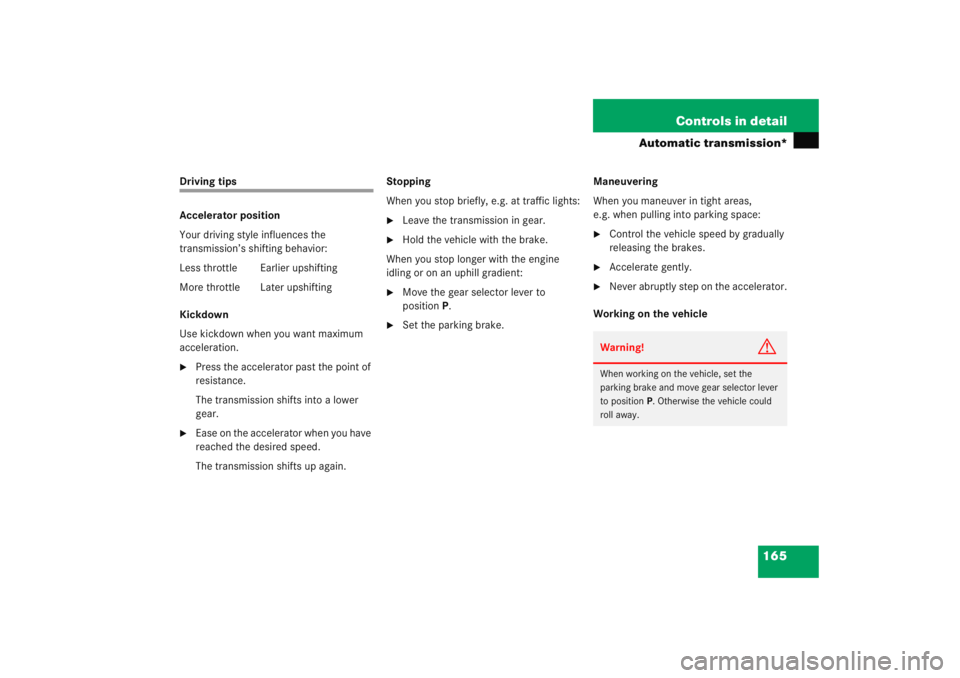Page 82 of 474

81
Safety and Security
Driving safety systems
� Driving safety systems
In this section you will find information on
the following driving safety systems:�
ABS (A
ntilock B
rake S
ystem)
�
BAS (B
rake A
ssist S
ystem)
�
ESP (E
lectronic S
tability P
rogram)
ABS
The Antilock Brake System (ABS) regulates
the brake pressure so that the wheels do
not lock during braking. This allows you to
maintain the ability to steer your vehicle.
The ABS is functional above a speed of ap-
proximately 5 mph (8 km/h) independent
of road surface conditions. On slippery road surfaces, the ABS will re-
spond even to light brake pressure.
The
- indicator lamp in the instrument
cluster (
�page 24) comes on when you
switch on the ignition. It goes out when the
engine is running.
Braking
At the instant one of the wheels is about to
lock up, a slight pulsation can be felt in the
brake pedal, indicating that the ABS is in
the regulating mode.
�
Keep firm and steady pressure on the
brake pedal while experiencing the pul-
sation.
Continuous, steady brake pedal pressure
yields the advantages provided by the ABS,
namely braking power and the ability to
steer the vehicle.
The pulsating brake pedal can be an indica-
tion of hazardous road conditions and
functions as a reminder to take extra care
while driving.
Warning!
G
The following factors increase the risk of ac-
cidents:�
Excessive speed, especially in turns
�
Wet and slippery road surfaces
�
Following another vehicle too closely
The ABS, BAS and ESP cannot reduce this
risk.
Always adjust your driving style to the pre-
vailing road and weather conditions.
iIn winter operation, the maximum ef-
fectiveness of the ABS and ESP is only
achieved with winter tires (M + S tires),
or snow chains as required.Warning!
G
Do not pump the brake pedal. Use firm,
steady brake pedal pressure instead. Pump-
ing the brake pedal defeats the purpose of
the ABS and significantly reduces braking
effectiveness.
Page 112 of 474

111
Controls in detail
Lighting
Manual headlamp mode
The low beam headlamps and parking
lamps can be switched on and off with the
exterior lamp switch.
Automatic headlamp mode
The following lamps switch on and off
automatically depending on the brightness
of the ambient light:
�
Low beam headlamps
�
Tail and parking lamps
�
License plate lamps
�
Side marker lamps
�
Turn exterior lamp switch to
position
U.
With the SmartKey in starter switch
position 1, only the parking lamps will
switch on and off automatically.
When the engine is running, the low
beam headlamps, the tail and parking
lamps, the license plate lamps and the
side marker lamps will switch on and
off automatically.
iWith the SmartKey removed from the
starter switch and the driver’s door
open, while the parking lamps or low
beam headlamps are switched on, �
a warning sounds
�
$ appears in the multifunction
display
�
the message
Switch off lights.
appears in the multifunction display
Warning!
G
If the exterior lamp switch is set to U,�
the headlamps may switch off unexpect-
edly when the system senses bright am-
bient light, for example light from
oncoming traffic.
�
the headlamps will not be automatically
switched on under foggy conditions.
To minimize risk to you and to others, acti-
vate headlamps by turning exterior lamp
switch to B when driving or when traffic
and / or ambient lighting conditions require
you to do so.
In low ambient lighting conditions, only
switch from position U to B with the
vehicle at a standstill. Switching from U
to B will briefly switch off the head-
lamps. Doing so while driving in low ambient
lighting conditions may result in an acci-
dent.
The automatic headlamp feature is only an
aid to the driver. The driver is responsible for
the operation of the vehicle's lights at all
times.
Page 114 of 474

113
Controls in detail
Lighting
Fog lamps
Front fog lamps
�
Switch on the low beam headlamps
(�page 110).
�
Pull out exterior lamp switch to first
stop.
The front fog lamps are switched on
The green indicator lamp‡ in the
exterior lamp switch comes on.
�
Push in the exterior lamp switch.
The front fog lamps are switched off.
The green indicator lamp ‡ in the
exterior lamp switch goes out. Rear fog lamp (driver’s side only)
�
Switch on the front fog lamps
(�page 113).
�
Pull out exterior lamp switch to second
stop.
The rear fog lamps are switched on.
The yellow indicator lamp
† in the
exterior lamp switch comes on.
�
Push in the exterior lamp switch to first
stop.
The rear fog lamp switches off.
The yellow indicator lamp † in the
exterior lamp switch goes out.
The front fog lamps remain lit.
Warning!
G
In low ambient lighting or foggy conditions,
only switch from position U to B with
the vehicle at a standstill. Switching from
U to B will briefly switch off the head-
lamps. Doing so while driving in low ambient
lighting conditions may result in an acci-
dent.iFog lamps will operate with the parking
lamps and/or the low beam headlamps
on. Fog lamps should only be used in
conjunction with low beam headlamps.
Consult your State or Province Motor
Vehicle Regulations regarding permis-
sible lamp operation.
iThe fog lamps cannot be switched on
with exterior lamp switch in
position U. For switching the fog
lamps, turn exterior lamp switch to
position B first.
Page 117 of 474
116 Controls in detailLightingHazard warning flasher
The hazard warning flasher can be
switched on all times, even with the
SmartKey removed from the starter
switch.
The hazard warning flasher switches on
automatically when an air bag deploys.
The hazard warning flasher switch is locat-
ed on the upper part of the center console.1 Hazard warning flasher switch Switching on the hazard warning
flasher
�
Press hazard warning flasher
switch
1.
All turn signal lamps are flashing. Switching off the hazard warning
flasher
�
Press hazard warning flasher
switch
1again.
iWith the hazard warning flasher acti-
vated and the combination switch set
for either left or right turn, only the re-
spective turn signals will operate when
the ignition is switched on (
�page 33).
iIf the hazard warning flasher has been
activated automatically, press hazard
warning flasher switch 1 once to
switch it off.
Page 128 of 474
127
Controls in detail
Control system
Menus, submenus and functions
Menu
1
Menu 2
Menu3
Menu4
Menu5
Menu6
Menu7
Standard
display
AUDIO
NAV*
Vehicle status
message memory
Settings
Trip computer
Telephone*
(�page 128)
(�page 129)
(�page 131)
(�page 132)
(�page 133)
(�page 151)
(�page 153)
Commands/submenusDigital
speedometer or
outside tempera-
ture
Select radio sta-
tion
Activate route
guidance
Call up vehicle mal-
function, warning
and system status
messages stored
in memory
Reset to factory
settings
Fuel consump-
tion statistics af-
ter start
Load phone
book
Call up mainte-
nance service
display
Select satellite
radio station*
(USA only)
Instrument clus-
ter submenu
Fuel consump-
tion statistics
since the last
reset
Search for name
in phone book
Check engine oil
level
Operate the
CD player*
Time/Date
submenu
Call up range
Lighting
submenuVehicle
submenuConvenience
submenu
Page 166 of 474

165
Controls in detail
Automatic transmission*
Driving tips
Accelerator position
Your driving style influences the
transmission’s shifting behavior:
Less throttle Earlier upshifting
More throttle Later upshifting
Kickdown
Use kickdown when you want maximum
acceleration.�
Press the accelerator past the point of
resistance.
The transmission shifts into a lower
gear.
�
Ease on the accelerator when you have
reached the desired speed.
The transmission shifts up again.
Stopping
When you stop briefly, e.g. at traffic lights:
�
Leave the transmission in gear.
�
Hold the vehicle with the brake.
When you stop longer with the engine
idling or on an uphill gradient:
�
Move the gear selector lever to
position P.
�
Set the parking brake. Maneuvering
When you maneuver in tight areas,
e.g. when pulling into parking space:
�
Control the vehicle speed by gradually
releasing the brakes.
�
Accelerate gently.
�
Never abruptly step on the accelerator.
Working on the vehicleWarning!
G
When working on the vehicle, set the
parking brake and move gear selector lever
to position P. Otherwise the vehicle could
roll away.
Page 169 of 474

168 Controls in detailGood visibilityAuto-dimming rear view mirrors*
The reflection brightness of the exterior
rear view mirror on the driver’s side and
the interior rear view mirror will respond
automatically to glare when�
the ignition is switched on
and
�
incoming light from headlamps falls on
the sensor in the interior rear view mir-
ror.
The rear view mirror will not react if
�
reverse gear is engaged
�
the interior lighting is turned on.
Warning!
G
The auto-dimming function does not react if
incoming light is not aimed directly at sen-
sors in the interior rear view mirror.
The interior rear view mirror and the exterior
rear view mirror on the driver’s side do not
react, for example, when transporting cargo
which covers the rear window.
Glare can endanger you and others.Warning!
G
In the case of an accident liquid electrolyte
may escape from the mirror housing if the
mirror glass breaks.
Electrolyte has an irritating effect. Do not
allow the liquid to come into contact with
eyes, skin, clothing, or respiratory system.
In case it does, immediately flush affected
area with water, and seek medical help if
necessary.
!Electrolyte drops coming into contact
with the vehicle paint finish can be
completely removed only while in the
liquid state by applying plenty of water.Warning!
G
Exercise care when using the
passenger-side exterior rear view mirror.
The mirror surface is convex (outwardly
curved surface for a wider field of view).
Objects in mirror are closer than they
appear. Check your inside rear view mirror
or glance over your shoulder before chang-
ing lanes.
Page 171 of 474

170 Controls in detailGood visibility�
Swing sun visors down when you expe-
rience glare.
�
To use mirror, lift up mirror cover2.
Rear window defroster
The rear window defroster uses a large
amount of power. To keep the battery
drain to a minimum, switch off the defrost-
er as soon as the rear window is clear.
The defroster is automatically deactivated
after approximately 6 to 17 minutes of
operation depending on the outside tem-
perature.
Activating�
Press button F or 1 in the
climate control panel (
�page 173) or
automatic climate.
The indicator lamp on the button
comes on. Deactivating
�
Press button
F or 1 in the
climate control panel (
�page 173) or
automatic climate again.
The indicator lamp on the button goes
out.
iIf sunlight enters through a side
window, disengage sun visor from
mounting 1 and pivot to the side.
Warning!
G
Any accumulation of snow and ice should be
removed from the rear window before driv-
ing. Visibility could otherwise be impaired,
endangering you and others.